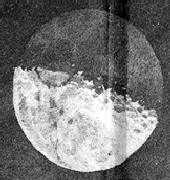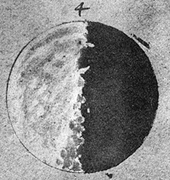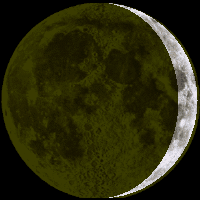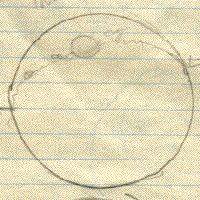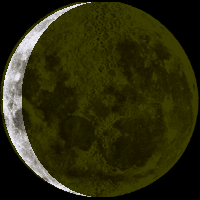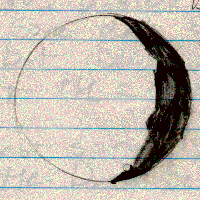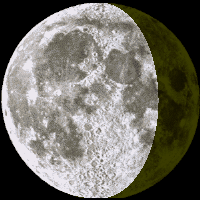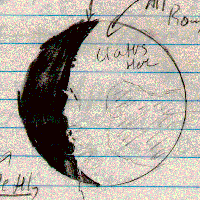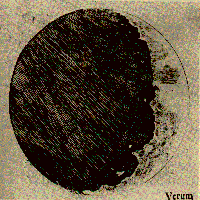Astronomy Group 1996
Project Web Page
The Moon
Purpose:
The astronomy group for Hist 333 is composed of Rebecca Brown, Travis Dunn, Karl Haushalter, and Jessica Williams.
We observed our Moon to complement our observations of Venus, Jupiter and its satellites, Orion and the Pleiades. We planned to examine the Moon with a telescope similar to Galileo's and compare our results with what he observed in the fall of 1609 and published in Sidereus Nuncius.
Background:
In the year 1610 Galileo published his Sidereus Nuncius, a record of his observation of the Moon and Jupiter in 1609 and 1610. The results of his observations began to threaten the cosmological system of Ptolemy, while at the same time provide evidence for the plausibility of the Copernican system. The ancient philosophers believed that the heavens were a realm of perfection and timeless immutability. They believed the Moon was smooth as a cue ball. Galileo observed features he interpreted to be mountains and craters on the surface of the Moon. He also noted that the terminator, the line dividing the light and dark regions of the Moon, was not a smooth line, as would be predicted by the Ptolemaics, but in fact displayed a jagged appearance . Galileo's observations of the Moon contributed to the of the Earth-Heaven Dichotomy, the idea that there is a fundamental difference between our terrestrial realm and the heavenly domain.
Expectations:
Below are some of the depictions that Galileo published in Sidereus Nuncius. We hoped to observe the same roughness along the terminator that Galileo say. We also wished to see the Earth-shine in the new moon, and we desired to see the mounta ins and pock-marks that Galileo reported. Ultimately, we intended to make our own drawings of the Moon as a vehicle to represent what we had seen.
Results:
We were able on several occasions to turn the Galilean telescope to the Moon and get good results. One of the problems with the Galilean telescope we have is that it only about nine power (Meaning linear distances are nine times the size, areas are e ighty-one times etc.). The field of view is also somewhat smaller than one might expect having had experience only with modern telescopes. We estimate that roughly one half of the Moon's diameter is visible in the view at one time. As a comparison and aid, we employed the use of another modern telescope which was sixteen power. These telescopes have a larger field of view, better optics, but they are designed such that images are inverted left to right, top to bottom. Hence, the drawings from these t elescopes are inverted as described above.
We were better able to view the Moon using modern telescopes, of course, but even with the nine power telescope we could discern that the terminator was uneven and most certainly not smooth. This is perceived as intrusions into the dark by the light or vice versa. The Earth-shine is light reflected onto the Moon by the Earth. It usually cannot be seen because the Moon itself is too bright, but when the Moon is near its New phase the Earth-shine can be seen. We observed it on March 22 (see drawing) and when looking through the Galilean telescope we could distinguish darker patches (the seas) in the dark half of the Moon.
Over the semester were able to see most of what Galileo reported. We observed an island of light surrounded by the darkness at one of the Lunar poles. One evening the terminator split one of the large craters, and differing shades of darkness could be perceived around and within the crater. We regularly saw smaller craters in the light half of the moon. By the end of the semster we were convinced that we had reproduced a significant portion of Galileo's observations, as much as could be expected w ith a telescope of only nine power.
March 22, 1996
Through Galilean Telescope
March 22, 1996
Through Modern Telescope
April 8, 1996
Through Galilean Telescope
April 8, 1996
Through Modern Telescope
Compare with another of Galileo's images from Sidereus Nuncius:
Future work:
By no means did we exhaust the possibilities for observing the Moon. Certainly much better drawings could be done by an individual with any sort of drawing skill, a talent lacking in our group. We were also unable to observe several days consecutive ly due to weather and scheduling constraints. A sequence of closely spaced observations would be useful to see how fast the terminator moves and surface features change over the period of one week. It would be useful to construct a telescope of higher p ower (sixteen of twenty) and contrast observations on it with observations of the nine power telescope. This is the most obvious and most relevant work that could be done in the future.
Sources:
Galilei, Galileo. Sidereus Nuncius or the Sidereal Messenger. Trans. and annotated by Albert Van Helden. Chicago: University of Chicago Press, 1989.
Images
- Top 4 of Moon: Sidereus Nuncius, found on The Galileo Project by Dr. Albert Van Helden.
- Moon Drawings: Travis Dunn except for March 22 Modern by Jessica Williams.
- Moon Images (not photographs):A program authored by Lorenzo Pasqualis.
- Yellowed Moon: Sidereus Nuncius translated by Van Helden.
The astronomy group also owes a tremendous debt of thanks to Dr. Albert Van Helden and Tom Williams for their knowledge and assistance.
Last updated 4/25/96
galileo@rice.edu
Last Revision: July 9, 2001
Electronic Text Center: etext@rice.edu.
